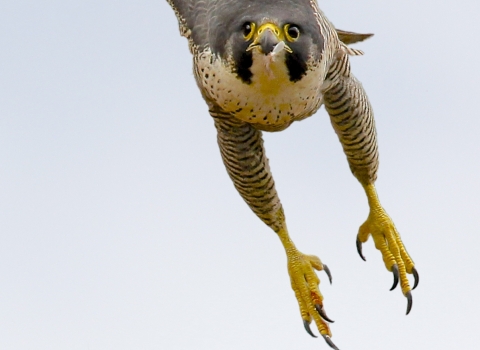
Steve Waterhouse
The worlds fastest bird lives here!
It all began in 2004...
That year a pair of wild peregrine falcons adopted Derby Cathedral's tower as their home.
After two years of unsuccessful breeding attempts on the tower, Derbyshire Wildlife Trust, Derby City Council, Derby Cathedral and Cathedral Quarter and a group of dedicated volunteers came together to build the pair a nest platform - and the birds laid their first eggs later that year! They have raised between one and four chicks each summer ever since, rearing 55 chicks. Most were colour ringed enabling them to be identified through a telescope. One was even discovered breeding on an inland cliff in North Yorkshire.
Each year the Derby Cathedral Peregrine Project brings thousands of people in the city closer to these incredible birds of prey and hundreds of thousands from over 70 countries via the peregrine webcams set up in 2007. Since then, the webcam has received over 4.5 million hits, 830 blog posts have been written with 22,000 comments received and over 200 Watch Point events have been held.
The peregrine is the world’s fastest animal, reaching unbelievable speeds of up to 390kph!
Let us tell you more...
The fall and rise of Derbyshire's peregrines
The peregrine is our probably our most charismatic bird of prey. It suffered a rapid demise in the 1950s and 60s due to the use of persistent pesticides, and by the 1970s, peregrines were so scarce that for several years not a single bird was seen in the county. After the pesticides were banned peregrine numbers started to slowly recover.
Since then peregrines have been making a welcome return to their former haunts. In 1984, after an absence of 30 years a pair bred again in the Peak District. By 2004, there were at least 15 nests, the birds using ledges on natural cliffs and quarry faces. Further south a pair adopted Willington Power Station's cooling towers, nesting there between 1993 and 2000, and rearing a total of ten young until the station was decommissioned.
Today peregrines can be seen across the county, both in our wild spaces and urban centres, Chesterfield as well as Derby, but sadly like the goshawk and hen harrier, they continue to be persecuted and still need our help.
How can I see the Derby Cathedral peregrines?
The Derby Cathedral peregrines can be seen from the ground by going to Cathedral Green, behind the Cathedral, and looking up with binoculars.
When the chicks show above the front of the nest platform, we run regular ‘Watch Point’ events providing telescopes so visitors get a close up view.
They also often perch on the lettering on the Jury's Inn Hotel nearby and are sometimes clearly visible as you drive into Derby on the A52.
However, by far the best way to catch a glimpse of these birds is via the webcams from home.
When is the best time to watch?
The webcams remain active all year and even in winter you can often see the parent birds on the tower. The cameras show both sides of the nest. A new camera giving a wide angled view of the nest was installed early in 2013.
The dates below will give you an idea of some seasonal highlights:
-
Mating - March
-
1st egg laid - Late March / Early April
-
Last egg - Early April
-
1st egg hatched - Early May
-
1st chick fledged - June
-
Learning to hunt - July
What do peregrines eat?
Great question!
The peregrines have been recorded taking 53 different kinds of birds including duck waders like snipe and lapwings, thrushes like fieldfares and redwings. They also take night flying birds like little grebes quail and even a water rail. They once brought in a rat – the only non-bird prey item we have ever recorded.
Wildlife crime and peregrines
Unfortunately, not all interactions with wildlife are positive and in some cases, birds of prey are deliberately killed. We are working closely with Derbyshire Constabulary to ensure that wildlife crime is stopped in Derbyshire.
First chick hatches for 2017 (https://www.youtube.com/watch?time_continue=9&v=mO070cPmiAU)
First Derby Cathedral peregrine chick hatches in 2017
The Derby Cathedral Peregrine Project (https://www.youtube.com/watch?v=tUiJLrQTO_c)
© Hen Harrier Action
The first of three films leading to the event: Hen Harrier Day - 'Action for Wildlife' at Carsington Water on Saturday, 10th August 2024
How you can help
This important project takes a great deal of time and resources. Thanks to a grant from The National Lottery Heritage Fund (formally Heritage Lottery) in 2012 and donations received so far, we have been able to continue to connect the people of Derbyshire with their peregrines.
Please continue to give to this project.The more money we raise, the more we can do to encourage people to love peregrines and take it upon themselves to ensure peregrines can thrive in our county.
Thank you
Donate to this important project



